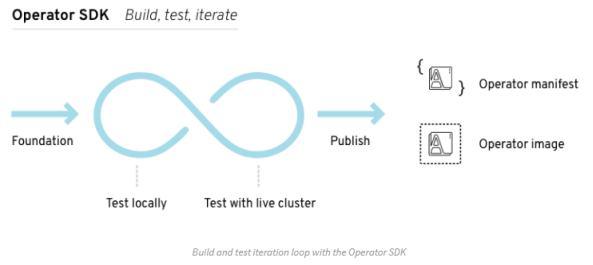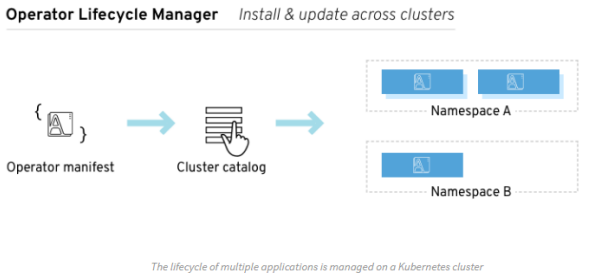
Introduction to Kubernetes Operators
In this fast-growing and technical world, it has become really important to keep an update on new technologies. Kubernetes Operators, a technology originally designed by Google, is now taken care of by the Cloud Native Computing Foundation. An application that is managed by using Kubernetes APIs and kubectl tooling and is deployed on Kubernetes is called a Kubernetes application. Packaging, deployment, and management of a Kubernetes application is done by using an Operator, which is why an Operator is acted as a backbone of the Kubernetes application.
What is Kubernetes?
Kubernetes (commonly stylized as k8s) is a portable, open-source system designed for automating scaling, management, and deployment of containerized applications. It groups containers that make an application into logical units for simple discovery and management.
Due to its large number of features, Kubernetes can be thought of as a micro-services platform, a container platform, a portable cloud platform, or many more. With the flexibility of Infrastructure as a Service (IaaS), it provides much of the simplicity of Platform as a Service (PaaS) and enables portability across infrastructure providers.
What are Operators in Kubernetes?
Operators are like a cloud, they provide services like provisioning, scaling, and backup/restore, and Kubernetes helps them in doing so, as operators can run anywhere where Kubernetes can.
Kubernetes Operator Framework
The Operator Framework is an open-source project that provides runtime and developer Kubernetes tools that help you improve an operator’s development. It consists of Operator SDK, Operator Lifecycle Management and Operator Metering (recently released feature).
- Operator SDK: It makes it easy for a developer to build his own operators without having prior knowledge of Kubernetes APIs and their complexities.
- Operator Lifecycle Management: It helps Kubernetes to provide an assertive way to install, update and manage operators and their dependencies. It also manages to give a good user experience.
- Operator Metering: It is responsible for collecting data and other happenings which are happening in the Kubernetes and then generate the report of the same.
1. Operator SDK
Packaging, building, and testing of an operator are done by a tool named Operator SDK. It provides API, which is required to build the app. It gives you an idea of how to upgrade, scale, or backup the application with those APIs. Over time, it allows engineers to make applications smarter and better user experience of cloud services. There are many essential practices and code patterns shared across the Operators and are included in the SDK, which helps prevent the duplication of a basic method that has already been made or optimized.
2. Operator Lifecycle Manager
When an operator is built, it needs to be deployed on a Kubernetes cluster, and to do so; we have an Operator lifecycle Manager.
- It is the backplane that smoothes the working of operators.
- It helps device controllers to control the namespace of an operator.
- It also helps the device controller to ensure who can communicate with running operators.
- OLM supervises the lifecycle of operators and their dependencies.
- It upgrades/updates the application involuntary.
Stateless and simple applications can leverage the Operator Framework’s lifecycle Management features without writing any code by using a generic operator (e.g., the Helm Operator). However, stateful and complex applications are where an operator is given appropriate importance. The cloud-like capabilities that are encoded in the Operator code can provide a better user experience and features like scaling, backups, and updates.
3. Operator Metering
A new version will soon be released. The application usage will be monitored and metered by an Operator Meter, which will ultimately help IT teams finance and budget software to software vendors. It is designed in such a way that it binds to the cluster’s CPU. It also helps to calculate customized metrics and other related data like licensing and Iaas Contact.
Benefits of Operator Framework
Given below are the benefits mentioned:
- Scales the Output: Being designed on the same principles that allow Google to run thousands of containers in a day, Kubernetes can scale without increasing your ops team.
- Never Outgrow: Kubernetes is very flexible with your needs as it helps you deliver both locally or globally available applications easily and steadily, no matter how complex your needs are.
- Can run Anywhere: Kubernetes is open-source, which gives you the freedom to take advantage of on-premises, hybrid, or public cloud infrastructure, letting you move workloads effortlessly to where it matters to you.
How to Create a Kubernetes Operator?
Operators are application-specific by nature, So, the hard work is to convert all of the application operational domain knowledge into a reasonable and logical configuration resource and control loop.
Some common and important steps to follow while building an Operator for any application are:
- Install Operators as a single deployment.
E.g. kubectl create -f https://coreos.com/operators/etcd/latest/deployment.yaml and don’t take additional action once it is installed. - Wait for the Operators to create a new third-party type when installing into Kubernetes. And then create a new application instance using this type.
- Operators should leverage built-in Kubernetes primitives like Replica sets and Services when possible to leverage well-understood and well-tested code.
- Operators should be backward compatible and always understand previous versions of resources that you have already created.
- Design your operator in such a way that application instances continue to run unaffected and effectively if the Operator is stopped or removed.
- A common source of operational bugs and security issues is not upgrading the software, and operators help you work on this more confidently. They give you the ability to declare the desired version and coordinate applications upgrades based on the desired version. So, make sure that you are applying this feature while building your own operators and avoid Kubernetes mistakes.
- Test your Operators against a “Chaos Monkey” test suite that simulates potential failures of Pods, configuration, and networking.
Recommended Articles
This has been a guide to Kubernetes Operator. Here we have discussed the concepts and different types of Kubernetes operators in detail. You can also go through our other suggested articles to learn more –



